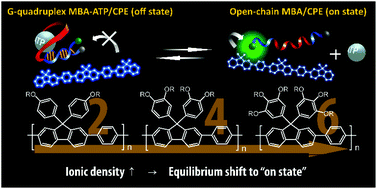Control of electrostatic interaction between a molecular beacon aptamer and conjugated polyelectrolyte for detection range-tunable ATP assay†
Abstract
A new strategy to modulate the detection range of a molecular beacon aptamer (MBA)/conjugated polyelectrolyte (CPE)-based adenosine triphosphate (ATP) assay is suggested. The hairpin type probe, MBA contains the ATP-specific aptamer sequence in a loop part and a green fluorophore (6-carboxyfluorescein, 6-FAM) and quencher (4-((4-(dimethylamino)phenyl)azo)benzoic acid) at both termini of stem parts. Three kinds of water-soluble poly(fluorene-phenylene) based CPEs (MP2–MP6) were synthesized by varying the number of cationic groups (2 to 6) per repeat unit. In the absence of ATP, the hairpin MBA is transformed into open-chain conformation by forming a linear electrostatic complex with CPE, enabling facile fluorescence resonance energy transfer from blue-emitting CPEs to 6-FAM in MBA. In the presence of ATP, MBA forms a G-quadruplex with ATP where the close contact between the fluorophore and quencher results in the quenched PL signal of 6-FAM. The binding interaction between the aptamer and ATP in the G-quadruplex shows resistance to the structural opening by CPEs and the ionic density of CPEs was proved to have an important role in the structural transformation of the ATP-MBA G-quadruplex into the linear open-chain MBA/CPE complex. By increasing the ionic density of CPEs, structural transformation toward open-chain MBA/CPE complexes was accelerated due to enhanced electrostatic interaction between the MBA and CPE, resulting in a detection range shift to a higher [ATP]. By simply modifying the number of ionic groups in CPE, the population shift toward open-chain MBA/CPE demonstrates the successful tuning of detection range from nanomolar up to millimolar concentrations of ATP.

- This article is part of the themed collection: Chemosensors and Molecular Logic


 Please wait while we load your content...
Please wait while we load your content...